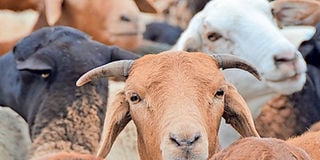How Kapiti scientists helped preserve the Red Maasai Sheep for Kenya’s farmers

Red Maasai and Dorper rams at the ILRI Kapiti Research Station in Machakos. With less rains, it is getting hotter and Maasai farmers are constantly challenged by drought-stricken lands. In this environment, the pure bred Red Maasai sheep is the favourite breed as it can withstand the drought and does not get as sick as the crossbreeds or the pure Dorpers. PHOTO | PAUL KARAMU | ILRI
What you need to know:
- International Livestock Research Institute (ILRI) had been maintaining this breed alive, as part of genetics research programme based at Kapiti Research Station.
- Through Kapiti training programmes and collaborations with local farmers on performance recordings and selection programmes, livestock keepers like Muyangai used purebred Kapiti rams on their crossbreeds and upgraded his and his neighbours’ flocks to even better performing Red Maasai breed, thus helping to sustain the breed.
- Based on advice from ILRI scientists, Muyangai now has about 600 sheep. Half of those are purebred Red Maasai and the other half are a crossbreed between the Red Maasai and Dorper.
- Using better genomic, information technology and reproductive tools, it is, therefore, now possible to achieve this.
For more than 40 years, livestock farmer Moses Muyangai from Isinya in Kajiado County in Kenya has been earning part of his living from selling crossbred sheep.
He rears two breeds, a ‘hairless’ indigenous breed known as the Red Maasai or Tanganyika short-tailed, which was traditionally kept by Maasai herders, and the Dorper, introduced in Kenya from South Africa in 1950.
The Red Maasai was the traditional breed kept by smallholder farmers and pastoralists in Kenya, Uganda and Tanzania, but when the meatier South African Dorper was introduced into the market, interest in the Red Maasai plummeted, to the point where in the late 70s and early 80s, the breed faced extinction.
That might not have mattered too much, at least to the farmers, who at first preferred the meatier, faster-growing Dorper — until late 2008 when the rains failed and the Dorper sheep began to grow perilously thin.
And then the rains failed again — and the Dorper sheep, weakened by hunger and disease, began dying off. It turned out that the Red Maasai breed was more resilient to drought, better able to withstand the variable climate of the region over the long-term.
But there was a problem: There were very few purebred Red Maasai left. Fortunately, the International Livestock Research Institute (ILRI) had been maintaining this breed alive, as part of genetics research programme based at Kapiti Research Station.
The programme is making comprehensive comparisons between the Red Maasai, Dorper and their crosses with respective to adaptive traits related to tolerance to gastrointestinal parasites and production attributes.
Through Kapiti training programmes and collaborations with local farmers on performance recordings and selection programmes, livestock keepers like Muyangai used purebred Kapiti rams on their crossbreeds and upgraded his and his neighbours’ flocks to even better performing Red Maasai breed, thus helping to sustain the breed.
Rams from Kapiti have also been shared with the Livestock Ministry’s Stud Flock in Naivasha to break the apparent inbreeding in the latter.
According to Okeyo Mwai, a principal scientist working for the Livestock Genetics Program at ILRI, who was in-charge of the sheep in 2005, “ILRI engaged with the locals by visiting the pastoralist communities, undertook a survey and held workshops to identify the concerns of the pastoralists.
To address the prevailing challenges, a rigorous selection and more planned crossbreeding programmes were initiated to produce better performing Red Maasai and crossbred rams for sale to the Maasai community.”
DROUGHT-STRICKEN LANDS
Based on advice from ILRI scientists, Muyangai now has about 600 sheep. Half of those are purebred Red Maasai and the other half are a crossbreed between the Red Maasai and Dorper.
The crossbreeds are bigger and heavier, giving good meat and milk production, and fetch a better price in the market.
The crossbred sheep sell from Sh6,000 — Sh8,000 each and the pure Red Maasai goes for between Sh5,000 and Sh7,000 each.
However, Muyangai prefers the pure bred Red Maasai because he and other farmers like him have begun to notice that the climate is changing.
There are fewer rains, it is getting hotter, and Maasai farmers are constantly challenged by drought-stricken lands. In this environment, the pure bred Red Maasai is his favourite breed as it can withstand the drought and does not get as sick as the crossbreeds or the pure Dorpers.
Of course, the best outcome would be to develop a sheep with the growth potential of the Dorper and the resistance of the Red Maasai; a crossbreed with the strengths of both.
Using better genomic, information technology and reproductive tools, it is, therefore, now possible to achieve this.
ILRI scientists, using the Kapiti Research Station, have for many years studied the various breeds and are working with farmers like Muyangai and about 90 others from the region on crossbreeding sheep, keeping records and ear-tagging or identifying animals to aid selection and faster improvements.
“We have seen that when the drought comes, the pure breed survive better. They also don’t get very sick compared to the crossbred. We need to treat the crossbred for worms, but the purebred animals have the ability to survive longer without treatment,” says Muyangai.
A note on ILRI’s Kapiti Research Station
The International Livestock Research Institute (ILRI) is a member of CGIAR focusing on building sustainable livestock pathways out of poverty in low-income countries.
One of the many assets belonging to ILRI is the Kapiti Research Station situated along the Mombasa highway in Machakos county spanning approximately 32,000 acres of semi-arid rangelands.
This article is a series of feature stories to bring knowledge, awareness and transparency to the general public about the current and ongoing research conducted by ILRI and its partners to assist farmers and to provide sustainable livestock and agricultural solutions.
The writer is ILRI communications manager




